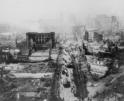
Culture

Flavin
It was the ninth inning of a tense game between the Red Sox and the Tampa Bay Rays on a recent night; the score was tied, five to five, after the Sox had squandered a five to nothing lead; Jackie Bradley Jr. was on first base; the public address announcer at the dump otherwise known as Tropicana Field announced a pinch hitter for the Red Sox; "Now batting for Boston, and making his major league debut, number 23, Michael Chavis."
Who?
Chavis, newly arrived with the Sox after being called up from Pawtucket, was coming to bat for the first time as a big leaguer. His name hadn't even been printed yet in the Rays' programs and most people in the the dump -- er, ballpark -- who did not follow the Red Sox closely had no idea who he was. They'd know soon enough.
With the count at two and two, Rays reliever Jose Alvarado, who had struck out Chavis in a spring training game a month earlier, unleashed a 99 mile an hour sinking fastball, down and in. Chavis was ready. He lashed a screaming line drive to center, directly at centerfielder Kevin Kiermaier. That's when things got interesting.
Kiermaier is a defender with uncommon grace and speed; he is the winner of two Gold Gloves, plus a Platinum Glove, awarded annually to the best defensive player in the league, regardless of position. He is known for his robbery of home runs in the far reaches of left center and right centerfields and for his diving catches of sure base hits. But, like virtually all centerfielders, he has an Achilles heel. He has trouble with line drives hit directly at him. Centerfielders tend to freeze for a moment when a ball is coming straight at them; they are unable to tell if it is hit with top-spin and will sink in front of them, or if it will carry over their heads. In a word, they get handcuffed. That's what happened to Kiermaier on the ball Chavis hit. He hesitated for a moment before realizing the ball was going long, then got turned around in the wrong direction and ended up back-pedaling furiously before lunging awkwardly for the ball as it sailed over his head. As soon as the ball was by him, he reverted to the Gold Glove Kiermaier, playing the carom off the wall perfectly and gunning a throw back to the infield.
Bradley held up at third and Chavis was in safely at second with a double and -- at that point -- a lifetime batting average of 1.000. As Kiermaier tried to compose himself in centerfield Andrew Benintendi hit a sacrifice fly to right, scoring Bradley with the go-ahead run in what would be a six to five Red Sox victory.
Kiermaier is hardly the only centerfielder to be victimized by a line drive hit directly at him. It happens eventually to all -- or almost all -- centerfielders. There was one who was never flummoxed by such drives. Dom DiMaggio handled them with ease, and he credited the stance he took in the outfield as the reason why.
He took his position, not facing straight in to home plate the way other outfielders did and still do, but angled toward the leftfield line. Thus, his left shoulder was pointed toward the pitcher, the same way that a right-handed hitter's would be. No one ever told him to do that, he just figured on his own that if a batter could react more quickly to a pitch by standing sideways to the pitcher, then a fielder should be able to do the same thing. The ability to read line drives more easily was an added benefit. The real advantage the stance gave him was in the quick breaks that he got on all fly balls. In 1948, he became the only player in American League history to have 500 or more putouts in a single season before the schedule was expanded from 154 games to 162. It has been done only twice since then, by Chet Lemon of the White Sox in 1977 and by Dwayne Murphy of the Athletics in 1980. Incidentally, the only other outfielder I ever saw who took his defensive stance facing the foul line was Dwayne Murphy. Isn't it interesting that two out of the only three outfielders in American League history to have made 500 or more putouts in a single season stood facing sideway toward the infield, but it has never been tried by anyone else?
No one comes close to that many putouts any more because the outfields are so much smaller in the new ballparks. More acreage in the outfield meant that fielders had many more opportunities to chase down long fly balls. A ball hit 415 feet to center that today woud be over the fence for a home run would, in the old days, have been just another loud out. For example, in the old Yankee Stadium it was 461 feet to centerfield, in Philadelphia's Shibe Park, 468 feet, and in Chicago's Comiskey Park and Detroit's Briggs Stadium, 440 feet. When Dom DiMaggio played seven decades ago, Fenway Park's measurements were the same as they are today, 390 feet to straight away centerfield and 420 to the triangle in right center. He is the only player who played in a park with such a small outfield to amass so many putouts. By way of comparison, the most putouts Jackie Bradley, Jr. has ever had in a single season is 365, and the most Kevin Kiermaier has had is 412, a total that DiMaggio exceeded in six different years.
To get back to more recent history, if you were not watching on television the other night, or if you were not one of the 21,000 hardy souls in and around Tampa who decided to take a trip to the dump, you would have no idea of the drama surrounding Michael Chavis's first big league at bat. He was not credited with an RBI, and there is nothing in the box score to indicate that the ball he hit reduced an award-winning outfielder to silly putty. But if you were watching, you'd have no doubt that Chavis was the man of the hour.
- Dick Flavin is a New York Times bestselling author; the Boston Red Sox “Poet Laureate” and The Pilot’s recently minted Sports’ columnist.
Recent articles in the Culture & Events section
-
Boston and the nation respond to the San Francisco Earthquake of 1906Thomas Lester
-
See you in the storyLaura Kelly Fanucci
-
'Dignitas' and the mediaRussell Shaw
-
Scripture Reflection for April 14, 2024, Third Sunday of EasterDeacon Greg Kandra
-
St. Helena's House is established in the South EndThomas Lester





